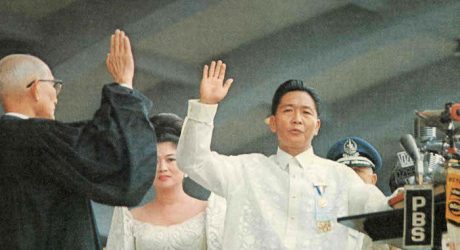
After suffering their biggest defeat in Mar Roxas’s loss in the 2016 elections and the ascent of President Rodrigo Duterte to the presidency comes another blow to anti-Marcos activists. The burial of former President Ferdinand E Marcos at the Libingan ng mga Bayani (Heroes’ Burial Grounds) looms imminent. Despite this burial of a once-hated historical figure long coming, many activists are acting like they’ve been taken by utter surprise. Seeing the way they now kick up a monumental tantrum over this, one would think that this is an “outrage” sprung upon them out of nowhere.
For one thing, the burial of Marcos at the Libingan was a campaign promise of Duterte from the very beginning. It is reasonable to presume that this promise along with others he made during his campaign are bundled into the mandate given him by Filipino voters in this year’s elections. Interestingly, however, some of Duterte’s voters and supporters are opposed to Marcos’s burial at the Libingan. Notable among Duterte’s supporters is former Secretary Rafael Alunan III who, in a 13th August Facebook post, appealed to Duterte to reconsider.
[…] we are protective of PRRD’s presidency; and any issue we see that could undermine his effectiveness and erode his political capital too early in the game compels us to speak out and point the way for his consideration and appropriate action.The issue is not whether FM deserves to be buried there being a past president and soldier, but whether he meets the qualifications of a “bayani” out of respect for those who lived up to the standards of heroism till the end. His ouster as President and commander-in-chief speaks for itself, and the exception to the rule that disqualifies a candidate should apply here.
Indeed, the name of the cemetery that is at the centre of this circus does contain the word “bayani”, Tagalog for “hero”. However, columnist Federico Pascual pointed out in a 24th April 2011 article published on the Philippine Star that this little fact may have caused unnecessary misconceptions about this revered burial ground. He quotes retired Brig. Gen. Rosalino A. Alquiza who, in an email to Pascual, cites AFP Regulations G 161-373, subject: ‘Allocation of Cemetery Plots at the LNMB,’ issued on 9 April 1986 by GHQ AFP under then AFP Chief of Staff Gen. Fidel V. Ramos and then President Corazon C. Aquino. In the email, Alquiza clarifies the matter:
The LNMB is a military cemetery (just like the Arlington Cemetery in the United States) intended primarily for military personnel and veterans. One does not have to be a hero to qualify to be buried there. Conversely, one acclaimed by some as a ‘hero’ is not entitled to be interred at the LNMB if he does not belong to any of the qualified categories.
What are these “qualified categories”? The AFP regulation is clear on what they are and includes this:
10. Former Presidents, Secretaries of National Defense, widows of former Presidents, Secretaries of National Defense and Chiefs of Staff.
Alquiza, in his email, further points out…
Marcos was neither dishonorably discharged nor convicted with finality of an offense involving moral turpitude. While he was charged with several offenses, he was never convicted. Thus, he died an innocent man.
Observers are beginning to note how the issue of Marcos’s burial at the LNMB has become one that is far out of proportion in the context of more pressing challenges being faced by the country and the administration of President Duterte. Indeed, it seems that it all really just boils down the notion of laying a dead man who was once President of the Philippines to rest and for Filipinos, as a people, to be the bigger persons in this “debate”. After all, the prevailing dogma being invoked by anti-Marcos activists and their shrill movement to block this burial revolves around just one side of history. This, however, is a side told by erstwhile political victors who have (along with their vintage 1986 people power narrative) now all but been discredited. As such, there is merit in considering the possibility that the side of the story that viciously demonises former President Marcos as well as his entire family was wrong or misconstrued for 30 years.
Fr. Ranhilio Aquino in his article Marcos should be buried at the Libingan published on the Manila Standard highlights this very notion as an important reason to reflect.
I do not want one version of history to be absolutized and enshrined as historical dogma. This is the version of those who oppose Marcos, because there is another version of the story (one which I favor) that maintains that he acted in his best lights, as the law and the system at that time allowed, and committed the sins and faults to which all of us must in one way or the other plead guilty!My real question is this: What exactly is the opposition to his burial at Libingan ng mga Bayani? By what logic? By what philosophical principle? By what ethical norm? By what legal precept? By what equitable standard?
In short, we should not be taking positions on matters such as these on the basis of who makes the loudest and most emotional appeals. Underneath the noise is a reference point begging to be found that must serve as a foundation for a more level-headed, more intelligent, and, ultimately, more sensiblediscourse. It’s time Filipinos step up to that standard.
http://www.getrealphilippines.com/blog/2016/08/opposition-marcos-burial-libingan-ng-mga-bayani-founded-hate-rather-reason/

No comments:
Post a Comment